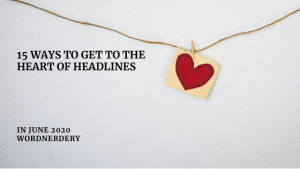 You’ve created a terrific article, blog post, marketing email or other sparkly bit of content. Now, how do you entice people to read it? Start with an appealing headline.
You’ve created a terrific article, blog post, marketing email or other sparkly bit of content. Now, how do you entice people to read it? Start with an appealing headline.
But wait, please don’t reach for a “clickbait” headline. You know, the ones that use alluring (but annoying) words and phrases like shocking, insane and you won’t believe what happens next to make readers click through to read a story. Upworthy – the “website for viral content” – is famous for this tactic, like this: “The Things This 4-Year-Old Is Doing Are Cute. The Reason He’s Doing Them Is Heartbreaking.”
Upworthy realizes the value of headlines in grabbing eyeballs, and its writers apparently create 25 alternatives before choosing one. SmartBlogger founder Jon Morrow writes 20 to 50(!) versions. Andy Crestodina of web design firm Orbit Media suggests writing a dozen or more.
You don’t necessarily have to spend that much effort crafting the perfect headline, but you can take extra care. Keep your readers in mind and think, “What’s in it for them?” Here’s a roundup of tips and advice:
1. Think about who you’re writing for and lead with the benefits. “What are readers going to get out of reading this piece? In what way will it inform them, or make their lives better?” asks writer and digital marketer Ann Handley in Everybody Writes.
2. Put those benefits into the first five words, especially in email, since words at the end may get cut off, says Andy Crestodina.
3. Keep it short but meaningful. “The headline writer is the poet among journalists, stuffing big meaning into small spaces,” says Roy Peter Clark in Writing Tools. Aim for six to 10 words; the first and last three are the most important. Online and on social media, aim for 55 characters or less.
4. Think about how your readers are going to find your piece. People searching for information online are busy, Andy says, so promise to answer their question in the headline. People on social media are bored and just browsing, so trigger interest and emotion.
5. Use lively words to paint a picture in your readers’ minds. Ann warns not to get carried away, though; “If something is surprising or awesome or ultimate…say so. If it’s not, keep mum.”
6. Play with words, even in serious stories, Roy says. “A rich writing vocabulary does not require big or fancy words,” he adds.
7. Substitute the unexpected for the familiar. Think of common words, phrases, sayings, even clichés related to the topic. For example, Neuromarketing author Roger Dooley cites Patrón Tequila’s ad, “Practice makes Patrón.”
8. Don’t be TOO clever, though. Don’t make the reader guess what you mean, especially if there is no image to explain.
9. Good headlines need a noun and a verb, and don’t bury the verb, says writing coach Ann Wylie.
10. Ask a question, suggests writing tutor Clare Lynch – but not one that has an obvious or yes or no answer. Example: “Are you paying too much for your health insurance? Here’s how to tell.”
11. Make a list based on what people are searching for, says blogger and author Molly Greene: “101 Fabulous Blog Topic Ideas.” (Make sure they ARE fabulous.)
12. Replace boring “label” headlines (also from Clare). A “label” headline might be “A message from the Community Relations team.” Replace it with something active, like “Sign up to volunteer this weekend.”
13. Use numbers to show value, says marketing expert Heidi Cohen for Social Media Examiner: “30 ways to make drinking tea more delightful.” Andy agrees numbers stand out against the text and make the headline more readable. Ann Handley says numbers set expectations.
14. Turn a comment about your topic into the headline, says Ann Wylie. What would your spouse, a classified ad or a joker in a bar say? Make that part of your headline.
15. Keep an inspiration file with headlines you liked or that led to lots of shares on social media. Some of the quirky ones I’ve collected: “Inmate flees in boxers, but freedom is brief” and “A farewell to farms.”
You can test your different headlines at CoSchedule.com. Be aware, though, that it rewards what they call “power words,” like remarkable, pioneering, ultimate. The headline on this newsletter came in at 77, which is pretty good for one without such words.
What’s your best tip for an engaging or effective headline? Have you spotted any great headlines lately? Please share in the comments. I’m always looking for interesting examples.
This post first appeared in the June 2020 issue of my newsletter. Wordnerdery is a quick read about words, effective/expressive writing, newsletters and more. Are you a subscriber yet? If yes, thanks for reading! If not, you can sign up right now. In keeping with Canada’s anti-spam laws and just plain good manners, you can easily unsubscribe any time.
